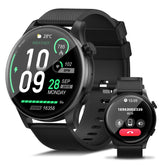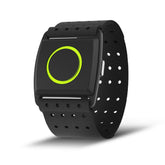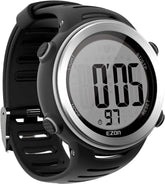Marathon Nutrition & Training: Fueling Strategies for Endurance Athletes
Marathons demand precision in both training and nutrition—and with a GPS running watch, you’ll optimize every mile and meal. This guide reveals science-backed carb loading, electrolyte intake, and recovery meals tailored to marathon training, ensuring you hit the starting line fueled and finish strong.
1. The Nutrition-Training Synergy
A. Calorie Burn vs. Fuel Intake
- Long Runs (>2 hours): Burn 800–1,200 calories/hour; replace with 60–90g carbs/hour during runs (e.g., 2–3 energy gels).
- GPS Watch Insight: Use your watch’s calorie burn data to adjust daily intake—e.g., a 32K run burns ~2,000 calories; add 500 extra carbs post-run.
B. Macronutrients for Endurance
| Nutrient | Training Phase | Daily Intake |
|---|---|---|
| Carbs | Base Building | 5–7g/kg body weight (e.g., 350–490g for 70kg athlete) |
| Tapering/ Race Week | 8–10g/kg (carbo-loading) | |
| Protein | All Phases | 1.2–1.4g/kg (84–98g for 70kg) |
| Fats | Low-Intensity Days | 20–25% of calories (avocado, nuts) |
2. Pre-Race Nutrition: Carb Loading Done Right
A. The 3-Day Carb Loading Protocol
- Days 3–2 Pre-Race: Gradually increase carbs to 10g/kg (700g for 70kg) while reducing mileage by 50% (tapering).
-
Sample Menu:
- Breakfast: 100g oats + banana (70g carbs).
- Lunch: Grilled chicken + white rice (150g carbs).
- GPS Watch Role: Track reduced mileage to ensure tapering doesn’t lead to underactivity (aim for 5,000–7,000 steps/day).
B. Pre-Race Breakfast (2–3 Hours Out)
- Goal: 1–1.5g carbs/kg + minimal fat/protein (easy digestion).
- Example: 2 slices white bread + honey (100g carbs) + cup of coffee (caffeine enhances fat oxidation).
- Watch Insight: Check resting heart rate (RHR)—a calm RHR (<60 BPM) indicates optimal readiness.
3. Race-Day Fueling: Stay Steady, Avoid Bonking
A. Mid-Race Nutrition (Every 30–45 Minutes)
- Carbs: 30–60g/hour (1–2 energy gels or 500ml sports drink).
- Electrolytes: 300–500mg sodium/hour (salt tabs or electrolyte drops)—critical if sweating heavily (lose 1–2L/hour).
- GPS Watch Alerts: Set reminders for gel intake (e.g., “Gel at 10K, 15K, etc.”) to avoid missed fueling.
B. Hydration Strategy
- Before the Race: 500ml water + electrolytes 2 hours out.
- During: Sip 100–200ml every 15 minutes—adjust based on thirst (watch’s elevation data can predict sweat rate on hot days).
4. Post-Run Recovery: Repair and Rebuild
A. The 30-Minute Recovery Window
- Nutrition Formula: 1.5g carbs/kg + 0.4g protein/kg (e.g., 105g carbs + 28g protein for 70kg).
- Perfect Combo: Chocolate milk (30g carbs + 8g protein) + banana (30g carbs).
- GPS Watch Use: Sync calorie burn to ensure you’re replenishing 100–150% of race-day energy expenditure.
B. 24-Hour Recovery Nutrition
- Protein Priority: 1.6g/kg body weight (112g for 70kg) to repair muscle micro-tears.
- Anti-Inflammatory Foods: Spinach, berries, and nuts to reduce post-race soreness.
5. Training with a GPS Running Watch: Key Insights
A. Mileage Tracking for Nutrition Adjustments
- Weekly Load: Gradually increase mileage by 10% (e.g., 50K → 55K) to avoid overtraining—use watch reports to monitor cumulative stress.
- Long Run Fuel Practice: Test gel timing and quantity during 20K+ training runs to refine race strategy.
B. Pacing for Even Energy Expenditure
- Negative Splits: First half at 85% effort, second half at 90%—use watch pace alerts to avoid starting too fast.
- Heart Rate Zones: Maintain Zone 2–3 (60–80% MHR) for the first 30K, allowing Zone 3–4 for the final 12K.
6. Common Nutrition Mistakes to Avoid
-
Overloading Fiber Pre-Race:
- Solution: Stick to low-fiber carbs (white rice, bananas) 48 hours pre-race to avoid gut issues.
-
Ignoring Electrolytes:
- Solution: Use a GPS running watch to track humidity and adjust sodium intake (e.g., add 20% sodium on hot days).
-
Delaying Post-Race Recovery:
- Solution: Set a watch alarm for “Recovery Meal” 30 minutes post-finish to ensure timely nutrition.
7. Gear Recommendations
A. GPS Running Watch Features
| Feature | Marathon Benefit | EZON Recommendation |
|---|---|---|
| Multi-Band GPS | Accurate mileage in urban canyons | EZON GPS Series (GPS + GLONASS) |
| Fueling Alerts | Customizable gel/electrolyte reminders | EZON Pro Running Watch |
| Battery Life | 30+ hours for ultra-distance training | EZON Endurance GPS Watch |
B. Nutrition Essentials
- Energy Gels: Opt for 25–30g carbs per gel (e.g., Huma or Gu).
- Electrolyte Tablets: Nuun or SaltStick for precise sodium/potassium ratios.
8. Sample Weekly Training & Nutrition Schedule
| Day | Training Activity | Key Nutrition Moves | GPS Watch Insight |
|---|---|---|---|
| Monday | Rest Day | Prioritize protein (1.6g/kg) + hydration | Monitor HRV for recovery |
| Tuesday | 16K Easy Run (Zone 2) | Post-run: 50g carbs + 20g protein | Track steady pace |
| Wednesday | Strength Training | Pre-workout: 30g carbs; post: 40g carbs | Active recovery steps |
| Thursday | 20K Tempo Run (Zone 3) | Mid-run: 1 gel; post: chocolate milk + rice | Pace alerts for Zone 3 |
| Friday | Rest or Yoga | Focus on sleep (7–9 hours) + electrolytes | Sleep staging analysis |
| Saturday | 32K Long Run (Zone 2) | Every 45 mins: 1 gel + water; post: 100g carbs | Fuel timing practice |
| Sunday | Active Recovery Walk | Light meal: salmon + quinoa + veggies | Step count (5,000–7,000) |
9. FAQs: Your Marathon Nutrition Questions Answered
Q: Can I carb load with fruits?
- Yes, but prioritize low-fiber options like bananas and melons to avoid digestive issues.
Q: How much water should I drink during the race?
- Aim for 500–1,000ml/hour, but adjust by thirst—overhydration is risky (hyponatremia).
Q: Should I train fasted for fat adaptation?
- Optional for short runs (<90 mins), but fuel for long runs to maintain performance and glycogen stores.
Fuel Your Body, Trust Your Training
With a GPS running watch and strategic nutrition, you’ll transform marathon training from a test of endurance to a science of optimization. Carb load with purpose, hydrate with precision, and recover with intent—all guided by data from your watch.
Race day is a celebration of months of effort—ensure every mile is fueled by knowledge and every meal aligns with your goals. Gear up, train smart, and let your nutrition and GPS watch be the partners that carry you across the finish line, strong and steady.
EZON Watch: Professional sports technology brand
https://ezonwatch.com
https://ezonwatch.com









